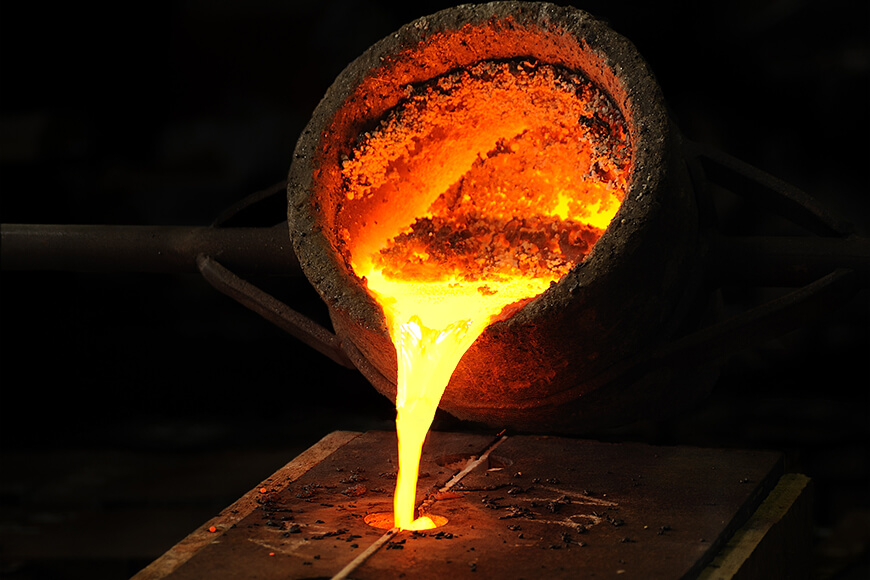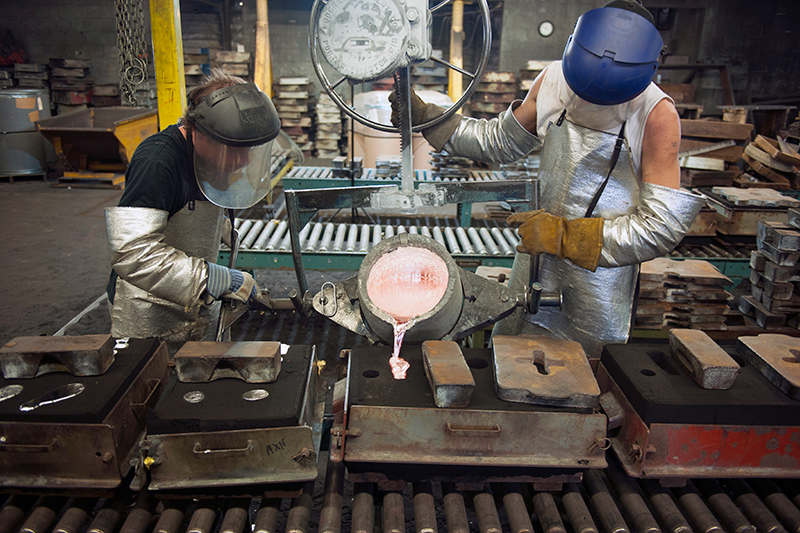How to Lower Environmental Impact Through Responsible Casting Foundry Operations
Wiki Article
A Comprehensive Overview to the Services Used by Casting Foundry Experts
Casting Foundry professionals play a vital function in the production market. They offer a wide variety of solutions that cover the whole Casting process, making sure accuracy and quality. From mold style to steel pouring techniques, each facet is carefully crafted. Quality assurance actions ensure that criteria are met. Nevertheless, the subtleties of these processes typically go undetected. Understanding the complete series of services can disclose their effect on numerous markets and applications.Understanding Casting Processes
Casting procedures might differ considerably, they all share a typical goal: changing raw products right into precise, functional forms. These procedures incorporate various techniques, consisting of sand spreading, pass away spreading, and financial investment casting, each suited to certain applications and products. In sand casting, molds are created from sand and a binding representative, enabling adaptability in design and size. Die casting, on the other hand, utilizes high-pressure shot to develop detailed forms from liquified steel, making sure high precision and repeatability. Investment Casting involves creating a wax pattern, which is coated in ceramic product, enabling remarkable surface area coating and dimensional accuracy. No matter the method picked, the basic concepts of heating, putting, and strengthening products stay consistent. By recognizing these procedures, makers can choose one of the most suitable strategy for their requirements, ensuring performance and quality in productionPattern Making Techniques
Pattern production methods play an essential function in the Casting procedure, offering as the blueprint for the last item. These approaches include creating an exact replica of the desired thing, which is then made use of to develop molds. Numerous materials, such as steel, plastic, or wood, can be used to craft patterns, depending upon the complexity and demands of the Casting project.Amongst the common strategies are solid patterns, which are straight and easy, and split patterns, which enable even more intricate designs by dividing the pattern into 2 halves. In addition, core patterns are utilized to create interior cavities within spreadings.
Improvements in technology have actually introduced electronic pattern production and 3D printing, allowing faster production and better precision (Casting Foundry). These advancements enhance the effectiveness and accuracy of the Casting procedure, guaranteeing that the end products meet rigid top quality standards while minimizing lead times
Mold Layout and Engineering
Mold layout and design are vital parts in the Casting procedure, affecting the total top quality of the final product. The style procedure entails careful consideration of product choice standards and the implementation of simulation and testing methods to ensure peak efficiency. Recognizing these aspects is vital for attaining reliable and reliable mold production.Design Process Summary
The design process for casting Foundry services is an important stage that incorporates mold and mildew style and design. This stage starts with understanding the specific requirements of the part to be generated, consisting of measurements, resistances, and general performance. Engineers utilize computer-aided design (CAD) software to create detailed versions, making sure accuracy in the mold and mildew's geometry.Partnership between customers and engineers is important, as it aids to resolve any kind of prospective style challenges early on. As soon as the preliminary design is accepted, prototypes may be developed for screening functions. This iterative procedure enables changes and improvements, making certain the final mold fulfills all specs. Ultimately, efficient mold and mildew style and engineering are crucial for accomplishing premium Casting results while maximizing production performance.
Product Selection Criteria
When determining the proper products for mold style and engineering, it is necessary to review various aspects that affect the efficiency and durability of the Casting process. Trick considerations consist of thermal conductivity, which impacts warmth transfer; mechanical strength, guaranteeing the mold and mildew endures stress; and resistance to wear and rust, which lengthens mold and mildew life. Furthermore, the compatibility of the product with the liquified steel is vital to stop responses that may compromise the spreading. Cost-effectiveness and ease of machining likewise play significant functions in product option. Inevitably, selecting the best materials lines up with the certain needs of the task, ensuring efficient manufacturing and high-grade castings. Proper assessment of these standards will certainly cause ideal mold performance and resilience.
Simulation and Checking Methods
Utilizing sophisticated simulation and screening methods is necessary for maximizing mold and mildew style and engineering. These techniques enable casting Foundry experts to predict how mold and mildews will certainly do under different conditions, thereby minimizing product waste and lowering preparations. Finite component evaluation (FEA) and computational liquid dynamics (CFD) are typically used to analyze architectural stability and fluid circulation within mold and mildews. By mimicing different circumstances, designers can determine potential concerns before physical production starts. Furthermore, prototype screening enables real-world validation of layout options, guaranteeing that mold and mildews satisfy efficiency requirements. Integrating these strategies not just enhances the precision of mold layouts however also adds to the overall performance and cost-effectiveness of the Casting process, leading to higher-quality last products.Steel Pouring Techniques
Putting molten steel into mold and mildews is an essential action in the Casting procedure, influencing the end product's top quality and structural stability. Various steel putting techniques are employed by casting factories to achieve excellent results. One of the most typical strategies include gravity putting, where metal streams right into the mold exclusively drunk of gravity, and pressure putting, which uses employed pressure to ensure full mold filling. In addition, vacuum cleaner putting is used to remove air pockets and boost surface finish, while centrifugal putting employs rotational force to distribute the metal equally within the mold. Each method uses distinctive advantages depending upon the kind of steel, mold style, and preferred characteristics of the end product. Foundry specialists analyze these factors very carefully to pick the most suitable putting approach, assuring that the Casting meets the called for specs and performance criteria. Comprehending these methods is essential for accomplishing high-grade spreadings in numerous industries.Heat Treatment and Completing Processes
Warm treatment and completing processes play a crucial duty in boosting the mechanical buildings and surface area top quality of spreadings. These procedures entail a collection of controlled heating and cooling cycles, which alter the microstructure of the steel, resulting in better toughness, ductility, and resistance to put on. Usual warmth treatment techniques include tempering, annealing, and quenching, each customized to accomplish particular material characteristics.Adhering to warm treatment, finishing procedures such as machining, grinding, and brightening are employed to achieve precise measurements and ideal surface coatings. These actions are required for reducing surface roughness and enhancing aesthetic allure, making certain that the end product fulfills the needed specifications. In addition, completing processes can entail finishing applications, which offer deterioration resistance and enhance resilience. On the whole, the combination of heat therapy and finishing procedures is vital for delivering top notch castings that satisfy industry requirements and customer expectations.
Quality Control and Screening
Quality control and screening are important parts in the Casting Foundry process, making sure that each item satisfies established requirements for efficiency and reliability. Foundries carry out strenuous testing procedures throughout manufacturing to examine and identify problems this link product homes. This consists of aesthetic inspections, dimensional checks, and non-destructive testing approaches such as ultrasonic or radiographic exams.
Using sophisticated modern technology, consisting of computerized measurement systems, improves precision in spotting prospective imperfections. In addition, material samples are frequently subjected to mechanical testing, examining strength, ductility, and hardness. These evaluations are necessary for validating that spreadings can hold up against functional stresses in their intended applications.
Adherence to sector standards, such as ASTM and ISO certifications, plays a considerable function in high quality assurance. By maintaining comprehensive documentation of inspection outcomes, factories can supply clients with self-confidence in the reliability and toughness of their cast products, ultimately cultivating lasting partnerships based upon trust fund.
Custom-made Casting Solutions and Applications
The value of tailored remedies in casting factories can not be overstated, as sectors progressively seek parts that meet specific demands. Customized Casting solutions permit the production of intricate geometries and special materials, satisfying diverse industries such as vehicle, aerospace, and energy. Foundries make use of innovative modern home technologies, consisting of 3D printing and computer-aided layout, to produce models and final items that align with customer specifications.Applications vary from intricate engine components to specialized equipment elements, highlighting the versatility of personalized castings. By working together closely with clients, factories can assure that each Casting not only satisfies useful demands however additionally abides by industry requirements. This modification leads to enhanced efficiency, minimized waste, and boosted efficiency in production processes. Eventually, personalized Casting solutions represent a critical benefit for businesses aiming to innovate and keep one-upmanships in their particular areas.

Regularly Asked Inquiries
What Products Can Be Utilized in Casting Processes?
The materials used in casting procedures include metals like light weight aluminum, iron, and bronze, in addition to non-metals such as plastics and ceramics. Each product provides unique residential or commercial properties suited for numerous applications and manufacturing requirements.Just how Long Does a Common Casting Task Take?
The duration of a typical Casting job varies substantially, commonly ranging from numerous days to weeks. Elements affecting this timeline include layout complexity, product choice, and the specific Casting strategies utilized by the shop.What Industries Benefit The Majority Of From Casting Solutions?
The sectors that benefit most from casting solutions include aerospace, vehicle, construction, and marine. Each field uses casting to generate accurate parts, enhancing effectiveness and efficiency in their respective applications, consequently driving innovation and development.Can You Supply Prototypes Before Full Manufacturing?

What Is the Normal Expense Range for Casting Providers?
The regular expense range for casting solutions varies significantly, frequently influenced by variables such as product type, production, and intricacy volume. Typically, prices can vary from a few hundred to numerous thousand bucks per project.These procedures include various approaches, including sand spreading, die casting, and financial investment casting, each matched to certain applications and materials. Mold and mildew style and engineering are critical elements in the Casting process, affecting the general quality of the final item. When identifying the ideal materials for mold and mildew layout and engineering, it is crucial to assess numerous factors that affect the efficiency and longevity of the Casting process. Pouring liquified metal into molds you can try here is a vital action in the Casting process, affecting the final product's top quality and architectural honesty. Quality control and testing are essential components in the Casting Foundry process, making certain that each product fulfills recognized criteria for efficiency and dependability.
Report this wiki page